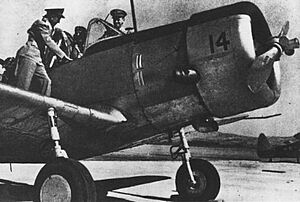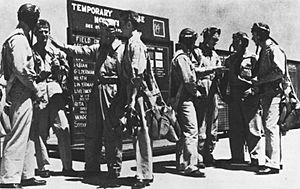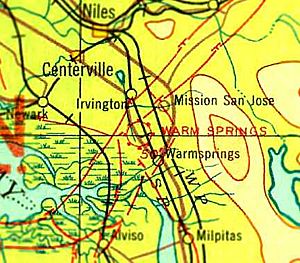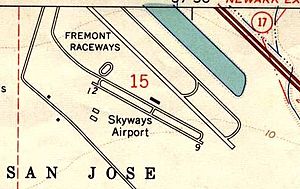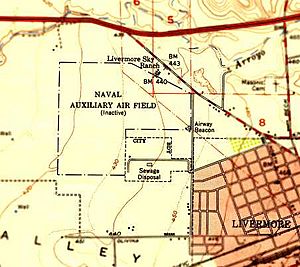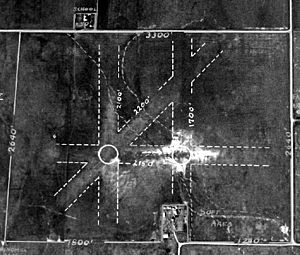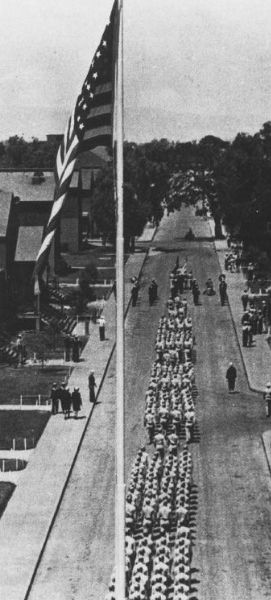Naval Air Station Livermore Outlying Fields facts for kids
During World War II, the United States Navy needed many new pilots. To help train them, Naval Air Station Livermore used special landing strips called Naval Outlying Landing Fields (NOLFs). These NOLFs were like smaller, quieter airports where pilots could practice taking off and landing without lots of other planes around. This helped them learn important skills without distractions.
Most of the pilots who trained here went on to fight in the Pacific War. The NOLFs usually didn't have many buildings or support staff. Naval Air Station Livermore opened in 1942 and closed in 1951. The outlying fields closed in 1945 after helping train over 4,000 new pilots. To set up these fields quickly, the Navy often used small local airfields that were once used for things like crop dusting or air shows.
Contents
Training Fields for World War II Pilots
The Naval Air Station Livermore had several Outlying Fields to help train pilots.
Abel NOLF
Abel NOLF was a training airstrip used during World War II. The Navy took over the Warm Springs Airport, which was built in 1933. They also built a new runway nearby. This airport became a satellite field for Livermore NAS in 1943.
It was located about 1 mile north of Milpitas, California. The Navy stopped using the runway in 1945. After the war, in 1946, it became a public airport called Milpitas Airport or Warm Springs Gliderport. It was used for airplanes and gliders, offering training and repairs. The airport had one unpaved runway that was 3,800 feet long. In 1952, the airport closed and was turned into a neighborhood with houses.
Brown-Fabian NOLF
Brown-Fabian NOLF was another training airstrip used from 1943 to 1945. The Navy used the Brown-Fabian Airport for pilot training.
This NOLF was located about 3.5 miles west of Tracy, California. It had a 6,300-foot grass runway. After the war, the site closed and is now used as farmland.
Cope Field NOLF
Cope Field NOLF was a satellite runway for Livermore NAS. It had a single 3,200-foot grass runway. This field was used from 1943 to 1945.
It was located 2 miles northeast of Pleasanton, California. Today, the area is a gravel pit.
Gelderman NOLF
Gelderman NOLF was a World War II training airstrip. It was used from 1943 to 1945. The Navy took over the Gelderman Airport for training.
Gelderman NOLF was located 4 miles north of Dublin, California. This satellite field had a 2,200-foot grass runway. The site is now covered by houses in San Ramon, California.
Heath NOLF
Heath NOLF was a training airstrip used from 1943 to 1945. The Navy rented 160 acres from the Heath family in Fremont, California.
Heath NOLF had a 3,100-foot concrete runway. In 1950, this runway became a public airport called Skyways Airport. Later, in 1959, it was renamed Sky Sailing Airport and became a very busy place for gliders. It had a glider school and offered glider rides. The Fremont Dragstrip also operated at the airport from 1959 to 1988. Part of the old Heath NOLF was used to build the I-880 freeway in 1984. The airport closed in June 1989 and is now a commercial area.
Lindeman NOLF
Lindeman NOLF was a training airstrip used from 1943 to 1945. The Navy took over the Lindeman Airport for training pilots.
Lindeman NOLF was located 9 miles northwest of Tracy, California, at an elevation of 2,000 feet. This satellite field had a 3,900-foot grass runway. The area is now covered by houses.
Livermore NOLF
Livermore NOLF was a training airstrip used from 1943 to 1945. The Navy took over the Livermore Sky Ranch, which was built in 1929, for training.
Today, this is the Livermore Municipal Airport, located 2 miles northwest of Livermore, California. This satellite field was just north of Naval Air Station Livermore and had a 4,000-foot grass runway. In the 1930s, the Civil Aeronautics Administration called it Livermore Intermediate Airport, an emergency landing field for civilian planes.
May's School NOLF
May's School NOLF was a training airstrip used from 1943 to 1945. The Navy built this field on 200 acres specifically for pilot training.
It was located 4.5 miles northeast of Livermore, California, near May School Road and Dagningo Road. This satellite field was also known as Silva Barthe Field and had four unpaved runways. In the 1990s, the site became a Federal Communications Commission antenna farm, known as the Livermore Monitoring Station. It is now just outside the city.
Rita Butterworth NOLF
Rita Butterworth NOLF was a training airstrip used from 1943 to 1945. The Navy took over the Rita Butterworth Airport for training.
This NOLF was located 3 miles northeast of Pleasanton, California. The satellite field had a 3,000-foot grass runway. Today, it is a vacant lot and commercial property, just north of the I-580 freeway.
Spring Valley NOLF
Spring Valley NOLF was a training airstrip used from 1943 to 1945. The Navy took over the Spring Valley Airport for training.
This NOLF was located 2.5 miles northwest of Pleasanton, California. The satellite field had a 3,500-foot grass runway. The area is now covered by houses.
Wagoner NOLF
Wagoner NOLF was a training airstrip used from 1943 to 1945. The Navy took over the Wagoner Airport for training.
Wagoner Airport was located 1.5 miles southwest of Livermore, California. It originally had a 3,000-foot grass runway. In 1943, the Navy built a 2,700-foot by 3,000-foot paved landing pad on the site. After the war, the site closed and was given to the county. The area is now covered by houses.


